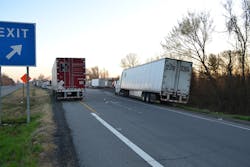Parking and your bottom line
Truck drivers give up nearly an hour of available driving time each day by parking early rather than risk not being able to find a spot further down the road, and that adds up to almost $5,000 in lost income annually, according to a new study.
The American Transportation Research Institute (ATRI) has released the results of its Truck Parking Diary research, where commercial drivers provided detailed documentation of their challenges in looking for safe, available truck parking. Participating drivers recorded their parking experiences and issues over 14 days of driving, representing over 4,700 unique parking stops documented in the diaries, and the specifics of these real-world experiences will be used to help inform policymakers about the range of concerns.
Among the findings, drivers looking for parking between the hours of 4 p.m. and midnight face a confluence of challenges—including increased search times and truck parking spaces clogged by non-commercial vehicles—which results in drivers parking in undesignated or unauthorized locations such as roadway shoulders or ramps during those same times.
Survey takers also chided other truckers for taking more than one designated space for their vehicles.
“The solution doesn’t require more pavement to deal with,” says ATRI President and COO Rebecca Brewster, “just better policing of those spaces.”
The ATRI truck parking diaries also quantified the negative impact that the electronic logging device (ELD) mandate will likely have on the parking issue when it takes effect at the end of the year. Drivers already utilizing ELDs were nearly twice as likely to spend over 30 minutes looking for available parking than did drivers without an ELD.
“[The spread] became noticeable to us in terms of the time drivers spend,” Brewster says. “It also corroborated what we saw in the open-ended responses from drivers who said, ‘When I’m operating with my ELD, I know I don’t have any time to spare. I know I need to go ahead and find a place now rather than risk running out of hours down the road. I don’t have the flexibility that a driver who isn’t on an ELD may have.’”
ELDs automatically record change-of-duty status to the minute, while paper logs use 15-minute blocks, the report notes.
“The ELD mandate will take away the flexibility that drivers with paper logs currently have, and drivers may adjust behaviors to find safe parking with reduced flexibility,” the study says.
ATRI’s research also documented the amount of lost revenue time for drivers who parked early. With an average of 56 minutes sacrificed per day, the parking shortage effectively reduces a driver’s productivity by 9,300 revenue-earning miles a year, which equates to lost wages of $4,600.
“I really do want to express how grateful we are to drivers who took the time to do this,” Brewster says. “In terms of data lift, this was the heaviest sort of request we’ve had for participants in quite some time.”
Most of the participants were in the truckload sector (56.1%), operated in the Midwest (35.5%) and Southeast (28.9%), drove dry vans (41.2%), were age 45-64 (71.4%), and were employee drivers (72.3%).
“The lack of available truck parking creates a lot of stress for me and my fellow drivers,” says Stephanie Klang, a professional driver for CFI and an America’s Road Team Captain. “And, as ATRI’s diary research shows, it’s a number of things that all combine to make this a perennial issue for us.”
Based on the diary findings, ATRI’s report offers recommendations :
- Public sector: Low-cost solutions to inadequate parking supply include increasing public rest area time limits to allow drivers to take mandatory HOS breaks and allowing parking at public facilities such as weigh stations and public works facilities. Long-term solutions require increased investments, such as reopening public rest areas that have been closed, expanding existing facilities, or developing new facilities.
- Truck stop operators: Inadequate supply could be improved by expanding existing private sector parking locations or building new ones. However, these solutions are capital-intense and face numerous legal obstacles, although there is some precedent for private truck stops using public sector funding. Separate parking for non-CMVs such as RVs and bobtails would free up spaces for tractor-trailers.
- Motor carriers: Carriers could pay for reserved spots (about 15% of drivers surveyed enjoy this service). This not only would increase driving miles but increase productivity beyond the cost of the fee. If carrier-paid reservation fees improve driver retention rates, that could lead to reduced training costs.
- Shippers/receivers: Providing drivers more flexibility in appointment times would allow drivers to shift times of operation to off-peak hours when there are more parking spaces.
- Truck drivers: Drivers’ open-ended responses indicate that planning is crucial to maximizing revenue-earning miles. Time spent searching for parking can be reduced by taking 10-hour required HOS breaks during off-peak demand hours, typically 5 a.m. to 4 p.m. Shifting days of operation to include weekends may also improve productivity, as there are fewer parking issues on weekends relative to weekdays.
Go to ATRI’s website at atri-online.org for a copy of the report
